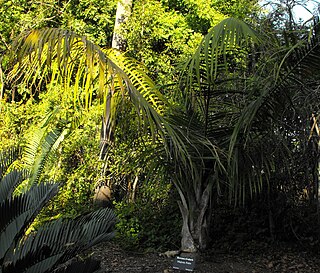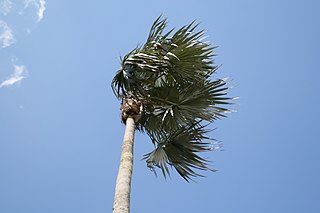
The Nicobar Islands rain forests is a tropical moist broadleaf forest ecoregion in the Nicobar Islands, which is part of the Andaman and Nicobar Islands union territory of India. The Nicobar Islands are in the Indian Ocean, lying north of Sumatra and south of the Andaman Islands. The islands are politically part of India, although physically closer to Southeast Asia. Millions of years of isolation from the mainland has given rise to a distinct flora and fauna, including many endemic species.

Livistona is a genus of palms, the botanical family Arecaceae, native to southeastern and eastern Asia, Australasia, and the Horn of Africa. They are fan palms, the leaves with an armed petiole terminating in a rounded, costapalmate fan of numerous leaflets.

Drosera peltata, commonly called the shield sundew or pale sundew, is a climbing or scrambling perennial tuberous species in the carnivorous plant genus Drosera. Among the tuberous sundews, D. peltata has the largest distribution, which includes eastern and western Australia, New Zealand, India, and most of Southeast Asia including the Philippines. The specific epithet is Latin for "shield shaped", a reference to the shape of the cauline leaves. It is either a single extremely variable species, or a complex of several closely related species of uncertain taxonomic boundaries. In Australia at least four forms have had or still have specific taxonomic recognition: Drosera peltata subsp. peltata, D. peltata subsp. auriculata, D. foliosa and D. gracilis.

Trachycarpus takil, the Kumaon palm, is a fan palm tree that is endemic to the foothills of the Himalaya in southern Asia. It is very similar to Trachycarpus fortunei, the windmill palm.

Ceroxylon quindiuense, often called Quindío wax palm, is a palm native to the humid montane forests of the Andes in Colombia and Peru.
Dypsis bejofo is a species of flowering plant in the Arecaceae family. It is a palm endemic to Madagascar. It grows on hilltops and slopes in rainforest habitat. The species is threatened by overcollection of seeds and by habitat loss. There may be only about 300 mature individuals remaining. Some grow in protected areas.

Ravenea rivularis, the majestic palm, or majesty palm, is a species of tree in the family Arecaceae. They generally grow to 10 to 12 feet tall and are often marketed in stores as a "houseplant" in a pot, in its natural state, the majesty palm may sometimes grow to 98 feet tall.

Coccothrinax proctorii, the Cayman thatch palm or Proctor's silver palm, is a palm which is endemic to the Cayman Islands.

Licuala spinosa, also known as the mangrove fan palm, is a species of palm in the genus Licuala. The plant is native to the wet places of fresh and salt water of Southeast Asia.

Chelyocarpus ulei is a species of palm tree that is native to the western Amazon.

Attalea phalerata is a species of palm tree known by the English common name urucuri palm, the Portuguese common name urucurizeiro, and the Spanish common name shapaja. Other common names include motacu and bacuri. It is native to Brazil, Bolivia, Paraguay, and Peru, where it grows along southern and western Amazonia. It is the most common palm tree on the Pantanal.

Hyphaene coriacea, the lala palm or ilala palm is a species of palm tree native to the eastern Afrotropics. It occurs in eastern Africa from Somalia to Kwazulu-Natal, South Africa, and is also found in the coastal flats of Madagascar and on Juan de Nova Island in the Mozambique Channel Islands.

Licuala ramsayi, commonly known as the Queensland fan palm or Australian fan palm, is a species of tree in the palm family Arecaceae which is endemic to northeastern Queensland, Australia. Two varieties are recognised: Licuala ramsayi var. ramsayi, and Licuala ramsayi var. tuckeri. It is the only species of the genus Licuala present in Australia.

Areca vestiaria is a species of palm native to the rainforests of eastern Indonesia especially North Sulawesi. It's morphology is more diverse than other species of palms, and in particular the color of its upper trunk / crownshaft changes depending on altitude.

Trachycarpeae is a tribe of palms in subfamily Coryphoideae of the plant family Arecaceae. It has the widest distribution of any tribe in Coryphoideae and is found on all continents, though the greatest concentration of species is in Southeast Asia. Trachycarpeae includes palms from both tropical and subtropical zones; the northernmost naturally-occurring palm is a member of this tribe. Several genera can be found in cultivation in temperate areas, for example species of Trachycarpus, Chamaerops, Rhapidophyllum and Washingtonia.

Raphia taedigera is a palm species in the family Arecaceae, colloquially known as yolilla in Central American Spanish. It is found in parts of Western Africa, Central America and South America.

Raphia sudanica is a palm species in the family Arecaceae. It is found in Western Africa, where it is locally used for construction purposes.
Raphia hookeri is a palm species in the family Arecaceae or Palmae. It is found in Western and Central Africa, where it is locally used to make palm wine. It is best noted for its very long leaflets which in the subspecies R. h. gigantea, of Ghana and Ivory Coast, can be 11 ft 6 in in length, while only two inches wide. These are the longest leaflets known from any plant.

Arenga hookeriana is a species of flowering plant in the family Arecaceae found in Peninsular Malaysia and Thailand.
Barclaya kunstleri is a species of aquatic plant native to Peninsular Malaysia, and Singapore. It is disputed. By some, it is treated as synonym of Barclaya motleyi, but by others it is regarded as a separate species.





















